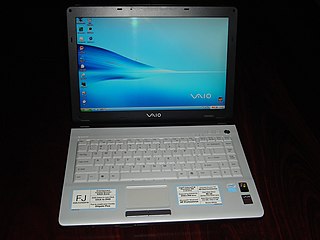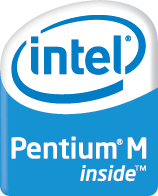VAIO Corporation, which is headquartered in Azumino, Nagano in Japan, is a manufacturer that makes personal computers and smartphones. VAIO was originally a brand of Sony, introduced in 1996. Sony sold its PC business to the investment firm Japan Industrial Partners in February 2014 as part of a restructuring effort to focus on mobile devices. Sony maintains a minority stake in the new, independent company, which currently sells computers in the United States, Japan, and Brazil as well as an exclusive marketing agreement. Sony still holds the copyright trademarks for the VAIO brand and logo. Currently in the US, VAIO products are sold by Trans Cosmos America, Inc.

A subnotebook is a class of laptop computers that are smaller and lighter than a typical notebook.

The Sony Vaio FJ series is a 14.1 inch notebook designed for Windows XP and the FJ270, FJ290, FJ330,FJ370 models in particular, are designed for Windows Vista. The FJ Series uses only the Pentium M processors using the Sonoma platform of Intel Centrino.
The MacBook Air is a line of laptop computers developed and manufactured by Apple Inc. It consists of a full-size keyboard, a machined aluminum case, and a thin light structure. The Air is available with a screen size of 13.3-inch (33.782 cm), with different specifications produced by Apple. Since 2010, all MacBook Air models have used solid-state drive storage and Intel Core i5 or i7 CPUs. A MacBook Air with an 11.6-inch (29.46 cm) screen was made available in 2010 through late 2016.

The Sony Vaio P series is a range of ultraportable subnotebook computers launched in January 2009.

Sony Vaio FW is a discontinued series of notebook computers which were the first laptops ever to have a 1080p 16.4" 16:9 widescreen LCD. Higher end models in the series can support an integral Blu-ray Disc reader or writer. The laptop weighed 3.1 kg. The battery lasts up to 2 hours. In June 2009, the ATI Mobility Radeon HD 3650 was replaced by the ATI Mobility Radeon HD 4650 with the release of the FW 4xx series. Additionally, Sony also released a special model of this series apart from the signature series models (Model:VGN-FW590FFD). This model had a futuristic themed cover and came equipped with moderately high-end specifications for $1069.99 U.S. dollars. The VGN-FW590FFD model was also only available for purchase through Sony Style's website.
Sony has used the Z model naming scheme for its high-end ultraportable notebook computers since 2000. Unlike other Sony models, the Z has always been manufactured in Japan or in the United States for some models. Sony has stated that production of the Z series will cease at the end of 2012.
The Vaio X series is a line of high-end ultraportable notebook computers from Sony introduced in September 2009, claiming to be the world's lightest notebook, at 655 grams ( ). It features an 11.1", 16:9, 1366x768 LED-lit LCD screen with built-in webcam, 2GB of DDR2 RAM, a choice of 64, 128 or 256 GB SSD, Intel Atom Z540 1.86 GHz or Z550 2.00 GHz, WWAN.
The Sony Vaio TT series was a line of high-end ultraportable notebook computers from Sony introduced in September 2008, with high-end features including an ultra-low voltage Core 2 Duo processor with DDR3 SDRAM; an 11.1", 16:9, 1366x768 LED-backlit LCD screen with built-in 0.3 megapixel webcam; choice of 1.8" hard drive or SSD ; and optional Blu-ray drive. The weight of the laptop is 1.3 kg.
The Sony Vaio SR series was a line of consumer-grade notebook computers from Sony introduced in July/August 2008 to replace the Sony Vaio C series range, as a part of the Intel Centrino 2 launch. They are equipped with a 13.3" screen and weigh approximately 1.95kg, significantly lighter than the C series, similar to the non-premium carbon fiber models of the SZ, but significantly heavier than the Z Series.

The Vaio S series was a line of notebook computers from Sony introduced in summer 2004. They have been touted as business laptops, and their designs have focused on being thin and light. They also have features friendly to businesspeople, such as TPM chips, matte (anti-glare) displays, RAID SSDs, and extended sheet batteries, as well as continuing to include RJ-45 and VGA (D-Sub) connections.
The Sony Vaio 505 series was a line of ultraportable notebook computers from Sony's VAIO brand. The introduction date in the United States was July 24, 1998.
The Sony Vaio 800 series was a range of Vaio laptops launched in 1998. It was produced until early 1999.
The Vaio F series is Sony's current multimedia and gaming orientated laptop. Launched in January 2010, it replaced the Sony Vaio FW series. Like the preceding model, it features a 16.4" screen, but with Full HD 1920x1080 resolution, 240Hz refresh rate, and LED backlight. The model came in two choices, 2D or 3D models. The 3D model is included with 3D glasses.
Sony VAIO AR series was a range of high-end multimedia notebook computers from Sony introduced in June 2006 as the first laptop with integrated Blu-ray drive. It replaced the AX Series. It featured a 17" 16:10 widescreen LCD screen, with choice of 1440x900 or 1920x1200 resolutions. It was replaced by the AW series.
The Vaio Y series is a line of notebook computer from Sony introduced in January 2010. It is a netbook-inspired model designed for travel use: compared with the other 13.3" models in the Vaio range, the Y lacks an optical drive, and is heavier and cheaper than the premium Sony Vaio Z series, but lighter than the consumer-grade Sony Vaio S series, with better battery life than either, thanks to the use of CULV processors. The weight is 3.92lbs (1.78kg).
The Sony Vaio E series is a range of consumer-grade laptops manufactured by Sony since 2010. The 14 and 15" laptops are configurable in a choice of bright colors: Passion Purple, Iridescent Blue, Caribbean Green, Coconut White, Hibiscus Pink, Lava Black and Gunmetal Black, while the 17" laptops offer only black or white. There is also an 11.6" version available. Each laptop each features up to 8GB DDR3 RAM, optical drive, Bluetooth functionality, 802.11b/g/n wireless and gigabit ethernet.
The Sony Vaio FZ series is a discontinued model of laptop sold by Sony in 2007. It replaced the Sony Vaio FE series, featuring Intel Core 2 Duo rather than Core Duo CPU, and other improvements. It was criticised for the low-resolution 1280x800 15.4-inch screen, poor battery life and its 2.7 kg weight. It was, however, praised for its display quality and the inclusion of Blu-ray drives on more expensive models.
The Sony Vaio G series was a range of ultraportable subnotebook computers launched in 2007 with a 12.1" display.







